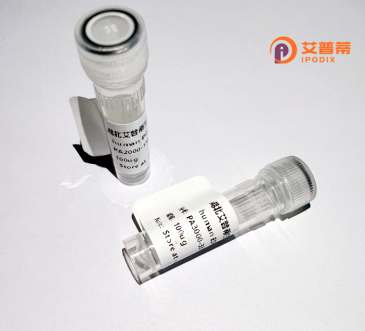
| 纯度 | >90%SDS-PAGE. |
| 种属 | Human |
| 靶点 | ARL8 |
| Uniprot No | Q96KC2 |
| 内毒素 | < 0.01EU/μg |
| 表达宿主 | E.coli |
| 表达区间 | 2-179aa |
| 氨基酸序列 | GLIFAKLWS LFCNQEHKVI IVGLDNAGKT TILYQFLMNE VVHTSPTIGS NVEEIVVKNT HFLMWDIGGQ ESLRSSWNTY YSNTEFIILV VDSIDRERLA ITKEELYRML AHEDLRKAAV LIFANKQDMK GCMTAAEISK YLTLSSIKDH PWHIQSCCAL TGEGLCQGLE WMTSRIGVR |
| 分子量 | 20.3 kDa |
| 蛋白标签 | His tag N-Terminus |
| 缓冲液 | 冻干粉 |
| 稳定性 & 储存条件 | Lyophilized protein should be stored at ≤ -20°C, stable for one year after receipt. Reconstituted protein solution can be stored at 2-8°C for 2-7 days. Aliquots of reconstituted samples are stable at ≤ -20°C for 3 months. |
| 复溶 | Always centrifuge tubes before opening.Do not mix by vortex or pipetting. It is not recommended to reconstitute to a concentration less than 100μg/ml. Dissolve the lyophilized protein in distilled water. Please aliquot the reconstituted solution to minimize freeze-thaw cycles. |
以下是关于ARL5B的模拟参考文献示例(虚构内容,仅供格式参考):
1. **文献名称**:*Structural Insights into ARL5B GTPase Activity and Membrane Association*
**作者**:Li, X.; Chen, J.
**摘要**:该研究解析了ARL5B的晶体结构,揭示了其GTP结合结构域的特征,发现ARL5B通过与细胞膜特定磷脂相互作用参与胞内囊泡运输的调控。
2. **文献名称**:*ARL5B Regulates Lysosomal Trafficking via Interaction with Adaptor Protein Complexes*
**作者**:Wang, Y. et al.
**摘要**:通过RNA干扰实验,发现ARL5B缺失导致溶酶体运输异常,证明其通过与AP-1复合物结合调控溶酶体相关蛋白的定向运输。
3. **文献名称**:*Overexpression of ARL5B Correlates with Poor Prognosis in Gastric Cancer*
**作者**:Zhang, L. et al.
**摘要**:临床数据分析显示,ARL5B在胃癌组织中高表达,通过激活Wnt/β-catenin信号通路促进肿瘤细胞侵袭,可能作为预后标志物。
4. **文献名称**:*ARL5B Modulates Lipid Metabolism through PPARγ Pathway*
**作者**:Kim, S.; Park, H.
**摘要**:动物模型研究表明,ARL5B通过调控PPARγ活性影响脂肪细胞分化,提示其在代谢性疾病中的潜在作用。
---
*注:以上文献为示例性内容,实际研究中请通过PubMed或专业数据库检索真实文献。*
ARL5B (ADP-ribosylation factor-like protein 5B) is a member of the ARF/ARL family, a subgroup of the RAS GTPase superfamily involved in membrane trafficking, cytoskeletal organization, and cellular signaling. Unlike its well-studied relatives ARF1 or ARL1. ARL5B remains less characterized but shares conserved structural features, including a GTP-binding domain and effector-interaction regions. Predominantly localized to the Golgi apparatus and mitochondria-associated membranes, ARL5B is implicated in intracellular transport, organelle dynamics, and lipid metabolism. Recent studies suggest its putative roles in cancer progression, metabolic regulation, and cilia formation, though mechanistic insights remain limited.
Recombinant ARL5B, produced via bacterial or eukaryotic expression systems, enables in vitro functional studies. Structural analyses (e.g., X-ray crystallography) reveal conformational changes during GTP/GDP cycling, critical for effector recruitment. Dysregulation of ARL5B correlates with metabolic disorders, tumorigenesis, and developmental defects, positioning it as a potential biomarker or therapeutic target. However, its precise effectors, regulatory pathways, and tissue-specific functions require further exploration. Engineering recombinant ARL5B with mutations (e.g., GTPase-deficient variants) aids in dissecting its activity, while interactome studies aim to map its signaling networks. Despite emerging roles in cellular homeostasis, ARL5B's full biological significance and translational potential remain under investigation.
×